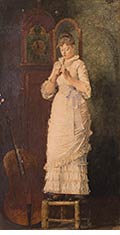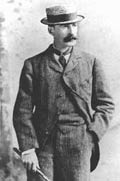Caffey eying rare Homer painting from Forsyth Gallery collection

"Winding the Clock," by Winslow Homer.

Stephen Caffey

Winslow Homer
A rare work in Texas A&M’s [Forsyth Galleries] (http://forsyth.tamu.edu/) by [Winslow Homer] (http://www.nga.gov/feature/homer/) , a preeminent figure in U.S. art history, is receiving its first-ever scholarly attention from Stephen Caffey, assistant professor of architecture at Texas A&M.
“His work captured the complexity of American identity in the late 19th century because, beginning with the Civil War, he was able to represent the conflict between North and South and changing gender roles without taking a stand,” said Caffey.
The largely self-taught, Homer (1836-1910) was a versatile artist who worked in a wide range of subjects, styles and mediums.
Last year, after asked to participate in Forsyth Gallery lecture series, Caffey learned of a Homer piece in the collection and opted to make the painting his lecture topic.
Caffey, who studied Homer’s work extensively in graduate school and is familiar with his catalog, was expecting to see a watercolor from Homer’s Adirondacks series, which depict deer hunting and fishing scenes created for businessmen who felt disconnected from nature because they were working in office buildings on the East Coast.
“As soon as I saw the piece in the Runyon collection my heart leapt because I knew no one had done any scholarship on it at all,” said Caffey. “I didn't even know it existed.”
Caffey has since learned that the piece, “Winding the Clock,” was published only once, prior to an 1881 New York watercolor exhibition.
The painting depicts a single woman in a claustrophobic interior space standing on a stool, blowing the dust off a key she’s holding to a grandfather clock.
“In addition to being technically astonishing because it shows a woman in a white dress with a lot of detail, which is almost impossible to do in a watercolor, it also presents a woman in a way we'd never seen before in American painting,” said Caffey.
Among the topics “Winding the Clock” addresses, he said, are single women in wealthy and well educated households, the potential symbolic meaning of winding the clock and the passage of time.
“The fact that it’s part of the Runyon collection is like finding the Titanic in terms of its potential to improve scholarly understanding of Homer's work and also to draw attention to the fact that Texas A&M owns this really important and little-known Homer painting,” he said.
Caffey and Nan Curtis, who was director of the Forsyth Galleries at the time, agreed to collaborate on a journal article which would detail the painting’s place in the broader series of Homer’s work and do research, partially funded by the Melbern G. Glasscock Center for Humanities Research, investigating its path in private ownership to the Runyon collection. Since Curtis' departure, Caffey has continued his research alone.
Caffey‘s effort will involve a trip to the Harvard University library, where the family papers of a Union Civil War officer who originally acquired “Winding the Clock” from Winslow are housed, the Boston Public Library, where a portrait of the officer is located, and Homer’s papers at the Smithsonian Archives of American Art.
After the Civil War, the Union officer told Homer he wanted to buy “Winding the Clock” after seeing it at Homer’s studio, where he was arranging a portrait session. Homer agreed on the condition the sale was completed after the 1881 New York watercolor exhibit.
Caffey said Homer began to attract attention internationally with a painting called “Prisoners From the Front,” displayed at the 1867 World’s Fair in Paris, which drew raves from French art critics.
“It depicts a Union commander with a group of Confederate prisoners,” he said. “In precise and nuanced ways he conveys the complexity and the ambivalence of the lingering tensions inherent after the Civil War.”
Homer’s not saying, continued Caffey, that the Confederate side is “right” or the Union side is “right”.
“What he’s saying is ‘this is a really complicated situation, so let me articulate that complexity in a way that’s permeated with ambivalence,’” said Caffey. “In his work,” he said, ‘I'm not advancing any sort of argument about it, I just want to observe it and present it to you.’”
Many in the U.S. are unaware of Homer’s stature in art history —a reflection, Caffey said, that’s characteristic of the field.
“Art history emphasizes the most obscure, the most esoteric, and most isolated,” he said. “It's an interesting distortion we really don't experience in any other type of history, where you always look at what was most popular, most influential, most widely understood.”
Because Homer was working in a traditional academic style, he wasn’t highly regarded by the intelligentsia, the avant-garde,” said Caffey.
The piece was recently on display, during the grand opening of the newly renovated Forsyth Galleries, located on the 2nd floor of the MSC.
The research project was noted in the Museum Education Monitor, which tracks and records research and resources in museum education with an aim of enhancing the development of theory and practice in the field by academics and museum professionals.
Tags
Related Posts

Study abroad prof edits Archimedes exhibit catalog

Lang, panelists, eye innovative curating
Glowacki discusses Greek gods in S.A.

New book details creation of historic Texas A&M buildings
Follow Us
Facebook Twitter Vimeo Youtube Flickr RSS
Recent Posts

Planning prof heads study of disaster housing aid

A message from the dean

Former student remembered as expert planner

Leading educator named new head of Architecture Dept.





_thumbnail_small.png)
